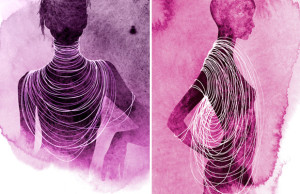Double Mitzvah – Emor

Written by David Bookbinder. David is an educator and part of the amazing leadership team of Jewrotica. For more of David’s columns, check out Double Mitzvah – Tzav, Double Mitzvah – Shmini, Double Mitzvah – Tazria, Double Mitzvah – Metzora, Double Mitzvah – Acharei Mot, Double Mitzvah – Pesach, and last week’s column Double Mitzvah – Kedoshim.

Huh? My gaydar is totally off today…
How can you tell if someone is gay? The internet provided me with a few helpful tips:
for a man (1)
1. owns a lot of shoes and/or grooming products (also, meticulously grooms)
2. likes Cher or Graham Norton and/or watching the Grammys
3. doesn’t like using public toilets
4. talks about gay rights, or quotes Oprah
5. compliments you on your fashion (“Gay men are often very fashionable, so see how clued up he is.”)
for a woman (2)
1. wears masculine clothes
2. likes music or movies featuring gay people or themes
3. has short nails and/or short hair
4. does not wear hardly make-up if at all
While everyone is entitled to their own beliefs, and there are always multiple valid perspectives on any given issue, personally I call bull****. However, it is hard to deny that in the venn diagram of stereotypes and actual characteristics there is a lot of overlap. So what gives? Is this based on truth or total nonsense? As always, our friendly neighborhood parashah, this week Emor (Leviticus 21:1-24:23), has the answer.
Here’s the parashah rundown. There is a long list of rules for the priesthood, among which are: no contact with the dead save for close family, don’t cut the sides of your beards, no gashes in your flesh (tattoos as an ancient form of magic), no uncovered heads (either bald or as a sign of mourning), no tearing clothes (in mourning), no taking God’s name in vain, must marry a virgin, and having a defect/deformity disqualifies you from making an offering. Following this is a list of all the holidays including Shabbat and the famous law of revenge “an eye for an eye and a tooth for a tooth.”(3)
At first glance some of the priestly laws seem at best arbitrary – e.g., no shaving or tearing one’s clothes – and at worst unfair and even offensive. Why should who I want to marry, virgin or otherwise, matter for the priesthood? And if God gave me some kind of deformity then why should that affect my ability to serve as a priest? And what lesson can I, in our modern era, take away from all of this? Offensive or not, these rules point out an unfortunate but very real truth about society – perception is everything.
The priests were looked upon as pseudo-perfection. They represented the mishkan, then the Temple, and by extension God. Therefore they had to be seen as embodying kedusha, holiness, which means embodying Israel’s unique societal notions of the ideal and perfection. Priests didn’t shave because the natural growth of one’s hair is what was seen as holy and perfect (contrary to surrounding cultures like the Canaanites and Egyptians). Marrying a virgin is what was seen as ideal; note that non-priests could marry non-virgins. A person with a deformity of some kind was seen as being deficient in someway and therefore not perfect. While we may not like the specifics, we can understand them in context. These views of what was perfect or ideal represent the reality of that time. And that reality can teach us a lot about our own reality today.
Very much like the society of the Torah, we expect certain groups of people to look or behave in a certain way. Think of the very concept of a ‘gaydar.’ The notion of being able to discern someone’s sexuality simply because of what they look like or how they act seems really offensive. But like I said earlier, if stereotypes are based in truth then what can we do to adjust our perspective?
One thing we can all do is separate the concepts of gender expression and sexuality. What I look like or how I act is not necessarily related to my sexual orientation. The Huffington Post article “Your Gaydar is Broken: Gender Expression Does Not Dictate Sexuality” makes this exact point. The conflation of these two ideas is not simply the media’s fault. It is the fault of every person who restricts another person’s gender expression to their sexuality.
But not all blame can fall on the media; we also have to blame the queer community. While we have pushed the hetero community for the binaries, we have also reinforced other binary identities within the queer community. Men can only wear heels if they’re impersonating women in drag. If they do wear heels, they’re “too feminine” and not wanted by many in this “masc4masc” homonormative world. We also associate sexual preferences with these gender expressions (the more masculine the guy is the more likely we believe he is a “top,” the more feminine the more we believe the person is a “bottom”). But we all need to realize that these are stereotypes and far from the truth when it comes down to daily, individual interactions.(4)
It is up to us to change things for the better. We must realize that gender identity and sexuality are so much more complicated than we sometimes think. The sooner this happens, the sooner we can all live in a more open, welcoming and non-judgmental world where we can be straight, gay, “bisexual, transsexual, queer, homosexual, asexual, pansexual, omnisexual, trisexual, agender, bi-gender, third gender, transgender, transvestite, intersexual, two-spirit, hijra, polyamorous, undecided, questioning, other, [or simply] Human (punctuation edited).”(5)
1. http://allwomenstalk.com/10-signs-hes-gay
2. http://chocolate-frogs.blogspot.com/2013/04/six-signs-she-might-want-to-get-into.html
3. also known as lex talionis
4. http://www.huffingtonpost.com/eliel-cruz/your-gaydar-is-broken-gen_b_5228195.html
5. http://www.nytimes.com/2013/01/10/fashion/generation-lgbtqia.html?pagewanted=2&pagewanted=all













0 comments